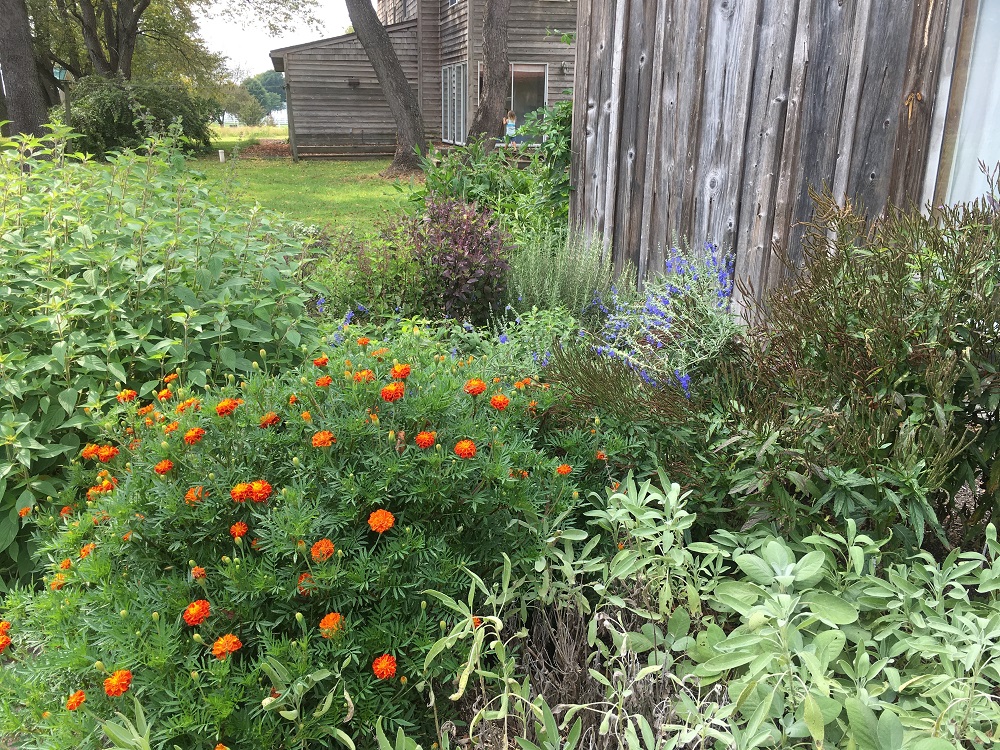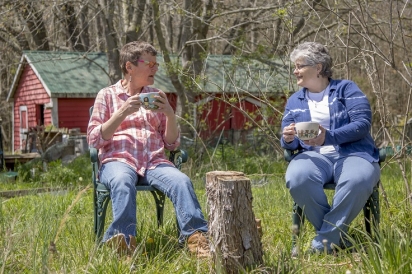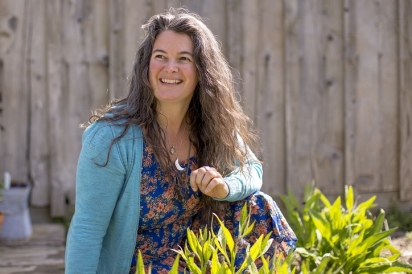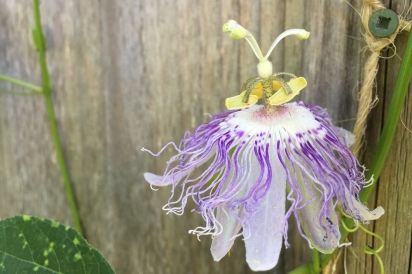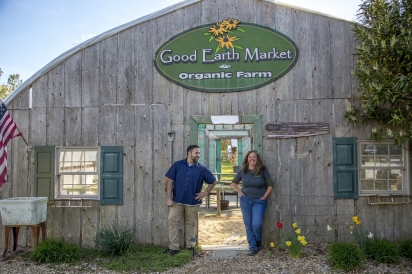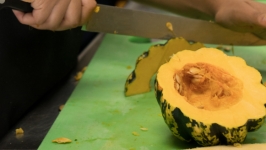Back to the (Herbal) Garden
Almost 80 years after Jethro Kloss published Back to Eden, devotees are still exploring the art of self-healing with herbal remedies and nourishing natural foods, all plucked from their own backyards.
Tyaskin, on Maryland’s Eastern Shore, lies nestled between the Nanticoke River to the west, and the Wicomico River to the east. The region, once fertile with juicy red tomatoes, now hosts Habanera Farm, the state’s only licensed herbal tea producer.
“This is beautiful land,” says health and wellness coach, herb grower and tea master Henriette den Ouden. “I’m from Annapolis. I’ve always lived in D.C.” Yet this city woman speaks reverently of the stillness of her remote surroundings and the vastness of the night sky’s starry canopy. At the foot of Whitehaven Road, an enchanting, throwback three-car ferry carries passengers toward Salisbury and civilization. Less than a mile away, Henriette and her partner Chris Himmel planted their herb farm in 2001 and opened the door to like-minded people to change their lives in soulful ways by offering one-on-one consultations and group classes.
GROWTH SPURT
Habanera Farm’s fields were fallow for a decade when Henriette and Chris purchased the property. Before that the landowners raised horses. Now the heavy clay soil, ripe with indigenous minerals, is rich in nutrients, too. Growing herbs on three-fourths of an acre and elderberries on two contiguous acres, Henriette, the couple’s primary farmer, begins each morning by watering her crops and then breaks fast, while she waits for the leaves to dry.
“The flowers need to be opening up,” she says before picking. “I love growing, have always been growing things,” adds the niece of a flower grower from The Netherlands. In a building on site she dries, bags and blends the herbs to create her teas. Some blends are sold wholesale, others retail at the Easton Farmers Market. A custom tea is crafted specially for serving at the landmark Whitehaven Hotel. And all strains — green, black, caffeinated and herbal teas — are packaged for online sales for the tea drinker who cannot make the trek to the remote Eastern Shore location. Yet, Henriette says, the farm is not without its many visitors.
“People are on vacation and think: ‘Let me go there.’ Guests from The Whitehaven Hotel step in once in a while,” she says. Recently an entire destination wedding party with some down time toured the farm. Though Habanera does not host a formal tearoom, Henriette says, “We have a little building where we process the teas and serve some tea on the porch.”
Imagine the quietude. Sipping tea brewed from the harvest of the surrounding gardens at this off-the-beaten track locale, and how that might drench the wandering soul searching for a tonic. Habanera Farm’s outreach is also extended to groups of area schoolchildren, garden clubs, women’s clubs, and students when classes are offered, like last spring’s free, grant-supported culinary course on preparing antioxidant meals for cancer survivors and caregivers.
BUMPER CROP
One of the farm’s most enduring crops, holy basil, enjoys a long growing cycle with multiple harvests each season.
“That’s a product that could be grown on a larger scale if there was more support for the processing and the marketing,” Henriette says. “I can’t grow enough.”
More and more frequently, Henriette propagates herbs from her own seeds inside a small greenhouse on site. She co-ops seeds and plugs, or seedlings, with two nearby vegetable growers who cultivate her herbs in their greenhouses. Every spring she sells plants during an annual open house. After the harvest, the tea master perfects her blends with a close-knit group of local tasters and testers.
“Every tea that we make is for pleasure,” she says. This year, she added Mediterranean iced tea to her line and when she vends at the Easton Farmers Market, regional festivals and holiday bazaars, she offers DIY tea tips. “Once you get the hang of it, it’s fun to brew your own tea,” she says.
From the Maryland University of Integrated Health she acquired additional knowledge, safety principles and herbal combinations for medicinal purposes. Her seminal ideas for farming have morphed alongside Maryland regulations and what the marketplace supports. In the process she has evolved in concert with her land.
“I had a romantic idea that [herb farming] was going to go well and it would be easy,” she says. But each season presents a new learning curve. “The holy basil, if it sits in the soil all winter, we have very few weeds,” she says. Some other herbs possess innate pesticide traits, like an odor that repels insects. “Up until this year, we had an enormous amount of bees, butterflies and toads that were not here when we came. That’s neat because we need bees. Have more herb farms, have more bees.”Have more elderberries, have more deer, too she learned. Until she can erect a fence, native white tail deer are ravaging her elderberry crop. Not to worry, though, the strain will survive. Some of Habanera Farm’s elderberry offshoots now thrive beside Joan Greeley’s apothecary near Lewes, Del. Henriette, Chris and Joan, another healing arts practitioner, are connected by the berries, and also by a shared education at Maryland University of Integrative Health.
FULL CIRCLE
About five miles from downtown Lewes, Joan strolls through her teaching garden on Goat Farm Lane, ticking off the names of each native plant species. In addition to the elderberries, she grows chickweed, purple nettle, sheep sorrel, sassafras, black cherry, plantain, chicory, ground ivy, violets, and lavender, dandelions, wild roses, evening primrose, honeysuckle, forsythia and Eastern red bud – some of which were on site when she bought the former turkey farm in 2012.
Adopting the sage wisdom passed along from an elder when she was a Tennessee park naturalist, Joan knows much more than just the names of each species. She understands why the plants grow where they do, their role in the ecosystem, and how they were used by first people nations — for medicine, for food, for resources.
Located on her three-acre property beside an outbuilding she repurposed as a consultation space, the garden is a peaceful place not only for its aesthetic beauty, but also as a mirror for reflecting the interactive nature of the relationship between plants and humans that is the root base of Joan’s practice: Plant Wisdom Within.
“My entire life has been leading up to this,” Joan says. “I always had an affinity for all things outside, the interconnectedness…finding the connections between plants and people, finding those inter-relationships. When I had a big personal health challenge and wasn’t able to get information from mainstream allopathic healthcare providers, I was drawn to the plant medicine.”
When she enrolled in the Maryland University of Integrated Health, one of the instructors was Dr. James Duke, ethnobotantist and co-author of her dog-eared bible: A Field Guide to Eastern and Central North American Medicinal Plants and Herbs.
“It was super full-circle for me,” she says. “My classmates and I spent many, many pleasant afternoons soaking up wise teachings in Jim’s gardens as part of our coursework. I spent extra time there volunteering and visiting whenever I could. He was a truly stellar human being, mentor and friend.”
When she completed her studies, the Lewes native brought indigenous plants back to her hometown. But the true nature of her practice is one-on-one, person-to-person.
“I don’t have a retail space where people can come in off the street and buy stuff,” Joan says. Rather than dispense Willow Bark to relieve a headache, she elects to probe the depths of a person’s symptoms to get to the root cause of the issue.
“Let’s hang out and talk about how foods might affect you, or how your headache might be related to your menstrual cycle, stress, dehydration, toxicity levels in your body,” Joan explains. “My headache formula is going to be really, really specific to each individual.”
After an initial two-plus hour intake session, most of her tea and tincture concoctions are blended from dried plant parts — stems and leaves — flowers and fungus, to be dispensed as teas, or infusions from aerial parts, like bark, berries, or roots that take longer to extract.
“A lot of time I’m working with people on resetting patterns that have been going on for a long period of time,” she says. The process might require months, instead of days and weeks, before her clients feel the results. Recently she treated someone for extreme fatigue.
“Moving from a place of real exhaustion, it’s been very beautiful to watch them return, saying: ‘The reason I took a nap was not because I had to do it; but because I stayed up late doing something I wanted to and because I was a little tired.’ The client was not bound by a need to rest,” Joan explains. That shift occurred within a month, but such rapid results depend upon the clients’ relationships with food and their daily habits.
“I see myself, and my clients see me, as a facilitator,” Joan says. “I’m not healing anyone. I am helping unhealthy people get out of their own way. I’m introducing them to possibilities they might have. People use the word healer, but I see it as enabling people to do something they might not be able to do on their own. That’s the pathway. When a healing is happening, I’m not doing it, a drug’s not doing it, a plant’s not doing it — it’s the human body that’s doing it. I help people encourage their bodies to pick up that mantle and run with it.”
EARTH MOTHER
Susan Ryan started her garden west of Bethany Beach on 10 acres that once supported a rotation of corn and soybeans.
“We built the garden and laid it out in raised beds, like a French or European intensive gardening system,” she says from her office in Good Earth Market and Organic Farm in Ocean View.
On land originally zoned as AR1 agricultural, Susan was permitted to re-zone for commercial use, knowing she would build a grocery and restaurant while the land was transitioning to organic.
GREEN THUMBS
Reared in Montgomery County, Maryland, Susan grew up in Olney, where her family moved when she was four years old.
“It was very bucolic,” she recalls, saying her parents left the city for that very reason. This is where Susan discovered her green thumbs and a passion for growing vegetables, herbs and flowers side by side.
“A lot in a small space,” she says to describe her aesthetic. Fringed with perennial flowers and bulbs, Susan says, “The first things I planted were perennial row crops, blueberries and blackberries, planted them beyond the raised bed garden in the field.” Other perennial vegetables and herbs, like asparagus, rosemary, lavender, oregano, thyme and mints followed in permanent beds.
Each morning her gardener harvests herbs and produce sold in the market’s retail space where Chef Nino Mancari browses daily for ingredients to prepare breakfast, lunch and dinner meals served in season. It’s not the easiest of processes, Susan says, but one that tests Nino’s creativity and inspires an eclectic menu for a clientele that has come to expect fresh, organic fare.
Good Earth Market’s gardens are the most photographed place in the entire county, says proprietor Susan Ryan, and they are open to the public. September 20, the day set aside for the annual farm dinner, tables will be set inside the garden for the fete that offers seating for 75 guests, a food-centric event for the seasoned palate.
WANT TO GO?
Habanera Farm
2916 Whitehaven Road, Tyaskin, Maryland (410) 873-2953; Facebook and Instagram
Plant Wisdom Within
18522 Little Goat Lane, Lewes, Delaware (302) 245-0691; Facebook and Instagram
Good Earth Farm and Market
31806 Good Earth Lane, Ocean View, Delaware (302) 537-7100; Facebook and Instagram


